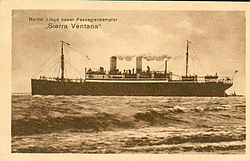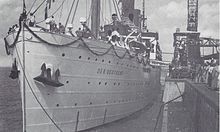Sierra Morena (ship)
|
The sister ship Sierra Ventana
|
||||||||||||||||||||||
|
||||||||||||||||||||||
|
||||||||||||||||||||||
|
||||||||||||||||||||||
|
||||||||||||||||||||||
The Sierra Morena was a passenger ship of the North German Lloyd (NDL) in Bremen , which was built for service to South America in 1924. From 1928 it was also used for cruises . In 1934 it was chartered to the German Labor Front (DAF) for their KdF cruises and renamed Der Deutsche . The ship was acquired by DAF in 1935, but still operated by NDL.
During the Second World War the ship served as a transporter and barge. Used as a transport for wounded in the final phase of the war on the Baltic Sea, it was aground on May 3, 1945 after British bombs hit the lightship Fehmarnbelt .
In 1947 the ship was lifted and repaired at the Warnow shipyard for the Soviet Union . In June 1950 the ship was put back into service as Asia and relocated to the Far East.
history
From 1912 onwards, Norddeutsche Lloyd commissioned four ships of the first Sierra class , which were supposed to secure a share of the emigrant and worker traffic to South America. These ships were lost in the aftermath of the defeat in the First World War . In order to regain the lost position on this route, special new buildings were set up by the NDL from 1922. After the Sierra Nevada (from 1925 Madrid ), a replica of the pre-war ships with two chimneys, three larger twin chimneys of over 11,000 GRT were built at the Vulkan shipyard in Bremen-Vegesack . While the first two ships ( Sierra Ventana , Sierra Cordoba ) also took over the names of the pre-war ships , the last ship launched on June 3, 1924 was given the name Sierra Morena , which was not previously used by NDL , after the Spanish low mountain range between Andalusia and Castile .
The Sierra Morena, which was taken over by the NDL on October 10, 1924, measured 11,430 GRT, was 155.7 m long, 18.84 m wide and had a draft of 7 m. The mast height was 34.5 m above deck. With a machine power of 6,400 hp , a top speed of 14.5 knots was achieved. Like the two sister ships, the ship had space for 1,100 passengers in two classes: up to 157 cabin passengers I class and 522 passengers III. Class in chambers and another 414 in dormitories. The ship had 18 lifeboats and was divided into eleven watertight compartments. The crew was 300 men. The Sierra Morena , which is part of the La Plata service, was also used for the first time to carry out a cruise in the summer of 1928, with space for 800 travelers. While the two sister ships were on other lines are used, the line service that ended Sierra Morena 1934 on the La Plata route that they are no longer with her sister ships, but assumed by the NDL since 1932 Hamburg-Süd -Schiffen Cap Norte as Sierra Salvada and Antonio Delfino served as Sierra Nevada . In 1934, the NDL had to withdraw from passenger service to the east coast of South America as part of the state-controlled reorganization of the shipping areas of the German shipping companies.
KdF ship The German
After the chartered Dresden sank in June 1934, the German Labor Front (DAF) chartered the Sierra Morena , renamed it Der Deutsche on July 20, 1934 and used it two days later for cruises by the National Socialist community " Kraft durch Freude " (KdF ) as a single class ship for 1,000 passengers. In 1935, the DAF bought the ship as the first ship in its own fleet, although North German Lloyd continued to manage the steamer. The sister ship Sierra Cordoba was also bought and converted into a one-class ship. The conversion of the ships turned out to be necessary as the previous multi-class ships caused trouble among passengers. As already converted one-class ship, the was Oceana of Hapag put into permanent charter. In March 1935 a KdF trip with shore leave was offered for the first time, as Der Deutsche , Sierra Cordoba , Oceana as well as the Stuttgart of the NDL and the St. Louis of Hapag with 3,000 passengers Lisbon and Madeira (so-called 1st "Madeira trip" of the DAF). In winter the "KdF-Flotte" ( Der Deutsche , Sierra Cordoba , Oceana ) also moved to the Mediterranean for the first time and carried out trips to Italy with land excursions from Genoa via Naples , Palermo and Bari to Venice and with new passengers on the return journey. In addition, the original five-day “fjord trips” were offered in summer. The usually closed use of the ships was intended and was intended to demonstrate the offer that existed for “all national comrades”. Eleven trips to Italy were carried out from November 1937 to April 5, 1938 by the three main ships of the DAF mentioned. In the following winter the political situation no longer allowed this. The huge interest in the voyages led to the purchase of the Oceana and the Stuttgart from the NDL in 1938 , which were also converted into a one-class ship. Hamburg-Süd, which also made its Monte ships available, had largely rebuilt them since 1935, but did not sell any ship.
In March 1939, Der Deutsche was used with the other KdF ships (including the newbuildings Wilhelm Gustloff and Robert Ley ) to transport the Condor Legion back . In autumn, the ship was used once in sea service in East Prussia after the attack on Poland . The rapid repair of the Vistula bridges and the annexation of Polish areas led to the abolition of the sea service.
The German was then involved in the repatriation of the Baltic Germans to the Reich . After the Hitler-Stalin Pact , the German Reich concluded resettlement agreements with Estonia on October 15, 1939 and Latvia on October 30, 1939. By the end of the year, more than 50,000 Germans from Latvia and around 14,000 from Estonia had already resettled, the majority in the newly annexed Wartheland district and Gdansk-West Prussia . A large number of passenger ships in Germany from various ports in Latvia and Estonia, including the East Asian express steamer Gneisenau and Potsdam as the largest ships and also three East Asia freighters of the NDL, were used for these operations, which carried out this resettlement in 169 trips to Danzig , Gotenhafen , Memel , Stettin and Swinoujscie coped with.
During the Second World War, Der Deutsche served as a transporter and then as a barge in Danzig and Gotenhafen for submarine crews. Used as a transport for the wounded in the final phase of the war on the Baltic Sea, it was also used in 1945 to transport refugees. Her first voyage began on January 25, 1945 in Pillau together with General San Martin . On May 3, 1945, Der Deutsche was aground with refugees on board after British bombs near the lightship Fehmarnbelt.
Soviet passenger ship Asia
After the Second World War in 1946, the German was awarded to the Soviet Union as spoils of war. In 1947 the ship was lifted and brought to Warnemünde . The repairs were carried out at the Warnow shipyard and on June 9, 1950, the former Sierra Morena was put back into service as Asia under the Soviet flag. Now equipped with a wide chimney, the passenger steamer was used in the Far East between Vladivostok and Kamchatka , where the Sibir (ex Oceana ), which had been repaired in Warnemünde , had also been relocated. In 1959 decommissioning was considered, but a modernization took place in Vladivostok. The ship was converted to oil firing and returned to service between Vladivostok and Kamchatka in September 1962. The Asia remained in service until January 1967 and was scrapped in 1970.
Fate of the sister ships
| Launched in service |
Surname | tonnage | Construction no. | fate |
| May 16, 1923 August 30, 1923 |
Sierra Ventana (2) | 11392 GRT 10750 dw |
610 | September 8, 1923 Maiden voyage to New York, first to South America in 1934, service on both routes until 1931 (also to Canada), from March 1932 to Cuba and Mexico, August 1935 sale to Italy, renamed Sardegna , on December 29th 1940 as a troop carrier in front of Valona by the Greek submarine Proteus sunk, which subsequently by the Italian torpedo boat Antares was sunk |
| 09/26/1923 01/20/1924 |
Sierra Cordoba (2) | 11469 BRT 10780 dw |
611 | January 26, 1924 Maiden voyage to La Plata, from 1927 also cruises, from 1928 to 1932 also four North Atlantic tours , 1935 sold to the German Labor Front for KdF-Reisen, during the war barracks in Kiel and Hamburg, taken over by the British in 1945 and burned out in January 1946 when towing wreck on trip to Scotland in January 1948 against Esbjerg dropped |
literature
- Arnold Kludas : The ships of the North German Lloyd 1920 to 1970 . Koehlers Verlagsgesellschaft, 1992, ISBN 3-7822-0534-0 .
- Arnold Kludas: The History of German Passenger Shipping Vol. IV Destruction and Rebirth 1914 to 1930 , Writings of the German Maritime Museum, Volume 21
- Arnold Kludas: The History of German Passenger Shipping Vol. V An era comes to an end from 1930 to 1990 , Writings of the German Shipping Museum, Volume 22
- Claus Rothe: German ocean passenger ships 1919 to 1985 . Steiger Verlag, 1987, ISBN 3-921564-97-2 .
- Reinhardt Schmelzkopf: German merchant shipping 1919–1939 . Verlag Gerhard Stalling, Oldenburg, ISBN 3 7979 1847 X .
Web links
- My first sea voyage on January 16, 1940 from Reval to Gotenhafen
- Asia model (PDF; 175 kB)
- Image of Asia
Individual evidence
- ↑ melt head, p. 173.
- ↑ melt head, p. 214.
- ↑ Kludas, Vol. V, pp. 130f.
- ↑ melt head, p. 225.
- ^ Kludas, Vol. V, p. 136.
- ↑ Dr. Karl Ploetz: Extract from the story . Publishing house AG Ploetz, Würzburg 1962.
- ^ Kludas, Vol. V, p. 144.
- ↑ Refugee transporter Fortunately, the German can be deployed
- ^ Article from February 1950 .
- ↑ Rothe, p. 99
- ^ Sinking the Sardegna
- ^ Fall of the Sierra Cordoba

